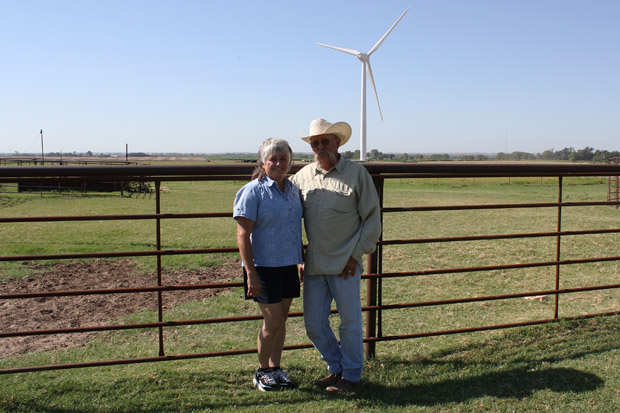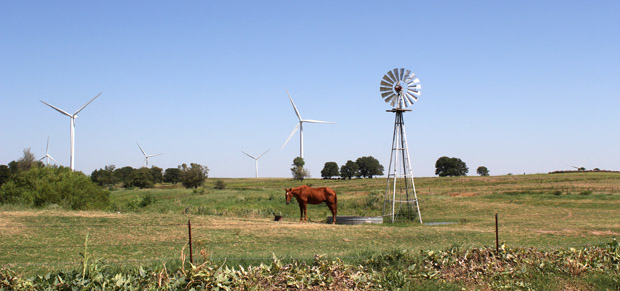
Tammy and Rick Huffstutlar have spoken out against wind farm development near their home in Calument, Okla.
Joe Wertz / StateImpact Oklahoma


Tammy and Rick Huffstutlar have spoken out against wind farm development near their home in Calument, Okla.
Joe Wertz / StateImpact Oklahoma

Joe Wertz / StateImpact Oklahoma
Tammy and Rick Huffstutlar's home near Calument, Okla., is surrounded by the Canadian Hills Wind Farm. The couple says they're considering moving because of the constant noise and shadow flicker.
Many Oklahomans are excited about the promise of wind energy, and the state is moving up the national ranks in wind power capacity.
But some are turning their backs on wind turbines, and the struggle highlights the challenges of regulating renewable energy.
When Tammy and Rick Huffstutlar bought their home and acreage 35 years ago, they were excited about living on a farm. But for the last year, Tammy says she’s been living in the middle of an industrial park.
“The turning of the blades, you can feel it,” she says. “There’s a pressure there, with each rotation, that thump.”
Huffstutlar’s farm is now surrounded by the Canadian Hills Wind Farm. The couple hates the turbines: the way they look, sound and make them feel. The Huffstutlars say it’s impossible to hide from the 400-foot turbines on their neighbor’s land — even inside the house. Tammy says they’ve had to add blackout shades to several rooms to block the strobing effect of the shadow flicker that flashes through the windows.
But strobing shadows, droning blades and ruined views are hard to regulate in rural Oklahoma counties, like Calumet — about 40 miles west of Oklahoma City — where the Huffstutlars live. Small cities and towns don’t have the same zoning rules as big cities. And because wind turbines don’t emit anything into the air or discharge anything into the water, wind farms aren’t regulated by the Department of Environmental Quality, the state agency that oversees coal and natural gas power plants.
The Oklahoma Corporation Commission, the regulator of oil and gas drilling and state electricity utilities, doesn’t oversee wind energy either, unless a wind project would impact ratepayers, says commission spokesman Matt Skinner.
In 2010, then-Gov. Brad Henry signed the Oklahoma Wind Energy Development Act, which went into effect on Jan. 1, 2011. The law requires wind operators to have liability insurance, and sets standards for landowner royalty payments and turbine decommissioning. But the law doesn’t address permitting, siting, or setbacks.
 Filling the Void
Filling the VoidThe absence of state wind energy policy has left a void that city and county politics are starting to fill. In Piedmont, a small city of about 6,000, many residents were excited when Virginia-based Apex Energy announced plans to build the 130-turbine Kingfisher Wind project, and were eager to make money by leasing out their land.
But city officials and other landowners were worried about wind energy negatives — like the experiences of people like the Huffstutlars — so the city passed ordinances to keep the wind turbines away. The debate about the wind project among city leaders spurred heated meetings, accusations of collusion and recall elections. Some wind-eager landowners even petitioned the city to redraw its boundaries to exclude them.
“From the first drive-by, things look good,” Piedmont Mayor Valerie Thomerson tells StateImpact. “The closer you get to a city — you start having to rethink this. A real issue is we don’t want our property values to go down.”
The same qualities that make Piedmont a great place to live — it’s rural, but just 30 miles northwest of Oklahoma City — are many of the same reasons that make the area an ideal setting for a wind farm, says Apex Energy Development Manager Kent Dougherty.
“Wind and wire is something we always look for,” he says. “We need the wind, and we need a way to get that wind energy to market.”
Oklahoma has plenty of wind — the state recently climbed the charts and is now No. 6 in wind energy capacity — but the state doesn’t have enough wire. Specifically, Oklahoma needs more high-capacity transmission lines to connect turbines to the power grid.
Wind developers say a new 700-mile transmission project called the Clean Line will help fill Oklahoma’s transmission gap, but that won’t be operational for at least five years. In the meantime, the wind industry is eying sites near already existing electrical infrastructure.
That means wind farms will be closer to people — and potential conflict, says Glen Andersen, the Energy Program Director at the National Conference of State Legislatures.
“As it expands into suburban settings it can create challenges for communities and also the state in regulating and promoting renewable energy,” he says.
Some states like Connecticut and Virginia regulate wind farms with rules that limit noise, establish distances from buildings, and address other issues like flicker and ice thrown from turbine blades. Connecticut also requires a public hearing for wind turbine projects, according to a state-by-state breakdown by NCSL.
Andersen says the debate, both locally and at state capitols, is likely to grow as wind farms expand into populated areas. Oklahoma’s state lawmakers are eager to attract the wind industry, and Andersen says there’s debate over whether wind energy should be regulated at all. Texas, for example, doesn’t — and it’s the nation’s leader in wind-generated electricity.
StateImpact Oklahoma is a partnership among Oklahoma’s public radio stations and produces journalism in the public interest, essential to an informed electorate. Help support informative, in-depth journalism with a donation online.